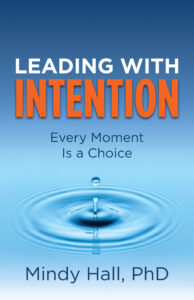Leading with Intention
When you meet someone, it doesn’t take long to know if they are living a life with intention, with purpose, with a design. Many people float through life waiting to see what will happen, going with the flow, and allowing others to decide the future. It’s the people who shape the future that stand out.
Living life with intention requires you to choose your actions and discipline your life in every moment. Mindy Hall, Ph.D. is the President and CEO of Peak Development Consulting, LLC. She has worked with clients around the world to strengthen leaders and help them live with intention. I had the opportunity to talk with her about her experience, her research, and her new book, Leading With Intention: Every Moment is a Choice.
The Importance of Being Intentional
Leading With Intention is a challenge for today’s leaders. Why is intention critical to leading today?
 Let me illustrate with a story from the book. A vice president of human resources worked in a company where the corporate offices were set up with two entrances: the front door from the lobby, which visitors were encouraged to use, and a side entrance marked “Employees Only,” which staff were required to use. The company’s senior-most executives could choose either door, and it was about the same distance from their parking spaces to their offices no matter which route they chose. Going through the side door took them past many other offices and common areas, allowing them to interact with other people in the company. Many of the executives, however, used the front door of the building, as they felt it provided quicker access to their offices, and therefore made better use of their time. What they failed to realize, however, was the gap between their intent and their impact.
Let me illustrate with a story from the book. A vice president of human resources worked in a company where the corporate offices were set up with two entrances: the front door from the lobby, which visitors were encouraged to use, and a side entrance marked “Employees Only,” which staff were required to use. The company’s senior-most executives could choose either door, and it was about the same distance from their parking spaces to their offices no matter which route they chose. Going through the side door took them past many other offices and common areas, allowing them to interact with other people in the company. Many of the executives, however, used the front door of the building, as they felt it provided quicker access to their offices, and therefore made better use of their time. What they failed to realize, however, was the gap between their intent and their impact.
The perception the executives created among employees was that they thought of themselves as separate—that they didn’t care to interact with the employees and did not have to follow the same rules. This behavior, although seemingly innocent, contributed to an “us-versus-them” feeling that began to impact the organization in very real ways—lack of belief in the espoused values of the company, lack of trust in the executives, and lack of engagement—all of which impact performance: Unintended consequences, but ones that show how easily actions send messages and how small behaviors can have a tangible impact.
These kinds of stories play out thousands of times a day at companies around the world. So much of our organizations’ potential is tied to a completely controllable variable: a leader’s awareness of their impact and their ability to choose behavior that intentionally shapes that impact.
How Others Perceive You Depends on How Present You Are
Compare and contrast with me two executives. One is leading with intention and the other clearly isn’t. What would you observe immediately that distinguishes the two?
You can see it most easily in how aware they are of their impact: the tone they set and how they are “showing up” to the organization. The most tangible dimension of this awareness takes shape in their communication skills—how present they are with others. What verbal and non-verbal cues are they sending to signal their engagement or lack thereof? Are they able to connect with their audiences in both informal and formal communications?
A leader’s currency is in his interactions, so the ability to inspire everyone from front line employees to senior executives and board members shouldn’t be taken for granted.
3 Phases to Become Consistently Intentional
You outline three phases to becoming consistently intentional. Let’s talk about each phase:
Step 1: Self-Awareness
The first is embodiment or self-awareness. You also say “notice yourself.” How do you help people be more objective when looking at self?
It’s a difficult skill to master: being in the moment and watching yourself in the moment at the same time. It takes practice. For those looking to build their skill, I’d suggest starting by reflecting on recent interactions. After a conversation or meeting, or at the end of each day, do an inventory of how you “showed up.” What did you signal with your behavior? What did you contribute? What did you diminish? Were there things you were thinking but didn’t say? Why? Do this for at least a week and you’ll begin to notice patterns emerge.
Next, be more intentional about how you want to be perceived. One of the most effective tools I know for doing this is also the most simple. I call it the 2+2: before key meetings and conversations, identify two questions you want to ask and two things you want to contribute. It doesn’t need to take a lot of time; you can do it as you walk to the meeting. But the simple act of being clear in your own mind about your intentions helps you come across as more grounded, prepared, and transparent. Again, do this for at least a week.
Once you’ve started to build your awareness skills, you’ll find that in-the-moment awareness will start to develop naturally. You’ll begin to notice your mindsets, filters, and triggers. In the course of a conversation, you’ll ask yourself questions like, “What is happening now? How am I contributing to what is happening? What am I choosing?” And with that knowledge, you can begin making more deliberate choices.
Soon, being able to do all that in the midst of a conversation—noticing your behavior and making adjustments to consciously shape the outcome of the interaction—will become second nature.
Step 2: Integration
The second is Integration. It’s the most frustrating part to move from cognitive to behavioral. Explain that challenge.
Integration is where we take cognition and attempt to turn it into behavior. Think, for example, about declaring that you are going on a diet: while your brain may fire up with that goal in mind, you still may reach for a bag of M&M’s before realizing, behaviorally, that you just ran counter to what your brain said you wanted to do. Or take the example of an executive who decides he wants to be more assertive in meetings but then falls into an old pattern of passively listening more than actively contributing. We often experience a series of fits and starts before we actually hold true, behaviorally, to what we say we want to do.
Step 3: Embodiment
The third is embodiment. It seems all success comes from consistency, yet we all struggle with it in some areas. How do you develop more consistency?
The length of time it takes to develop a new habit varies widely depending on the person, the behavior, and the context. On average, though, it will take between two and eight months. The great news, though, is that an occasional lapse doesn’t send you back to square one. You don’t have to be perfect.
So my biggest advice for people is to be patient with yourself and the process. It is supposed to take time. Find ways to consciously, regularly direct your attention to the behavior you’re trying to change. Those can be regular reflections you schedule into your day or meetings you schedule with an executive coach; external stimuli like pictures, notes, or alerts on your phone; or emotional or behavioral triggers. The trick is that they need to be regular, and they need to be ongoing. New behaviors are not built by one-time actions; they are built day by day, moment by moment. Every moment is a choice.
How You Dress Impacts Your Ability to Grow and Lead
When you were starting your professional career, your friend shared an analogy with you about your dress that stuck with you. Would you share that story?
Absolutely. My first job after college was running a nonprofit crisis center. I was on call 24/7. I spent a lot of time at police stations and hospitals. Most of the time I didn’t pay much attention to my appearance. If I got a call in the middle of the night I would throw on a pair of jeans and a T-shirt and out the door I would go. I probably should have looked much more professional, but I did not place much importance on the impact of my appearance.
A few years later, I took a job at a large, multinational bank where I was responsible for developing new leaders. When I started, a friend told me I needed to go out and spend some money on clothes. Now, I had no money. I had an entry-level salary, rent to pay, a car payment and student loans, and I am fairly certain that I did not even have a credit card. Spending money on a new wardrobe seemed impractical to me. I told my friend that if the company didn’t see me for the value I could bring—no matter what clothes I came in—it probably wasn’t the right place for me. Looking back, I was either incredibly naïve or incredibly arrogant. Here I was, a recent college graduate entering a new industry, and I expected a major, established corporation to accommodate my style. I thought, “They should not judge me based on my clothes; they should judge me for what I can contribute.” Then my friend asked me one of the best questions I have ever been asked. She asked, “If you went on a football field in a basketball uniform, how effective would you be in reaching your goal?” That analogy was an epiphany for me. “You have to get on the field to be able to affect the field. If you come on the field in a different uniform than is needed to play, you will never be able to affect the game the way you want to.” She was right. I still had no money, but I decided that I wanted to be on the field; I decided I wanted to affect the field. So I went out and invested in new clothes. The clothes were simply the price of entry, but without them my ability to have the influence I wanted would have been compromised. That was when I began to understand the power of how one “shows up”—physically and emotionally.
Leading With Intention: Every Moment is a Choice

